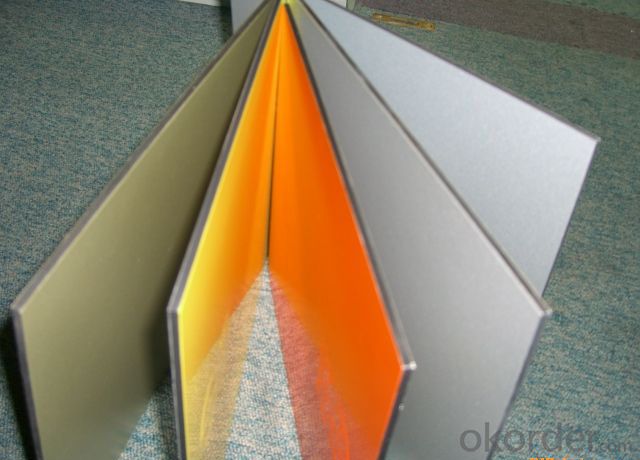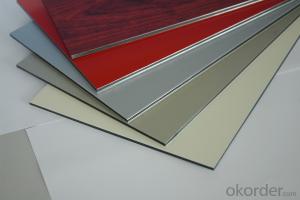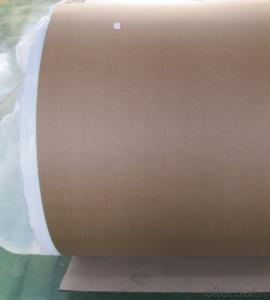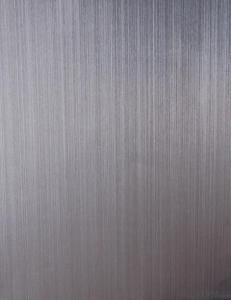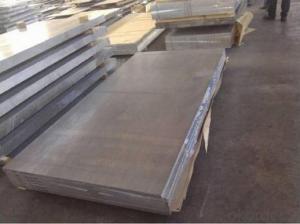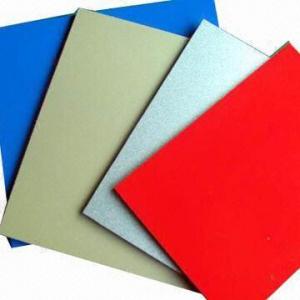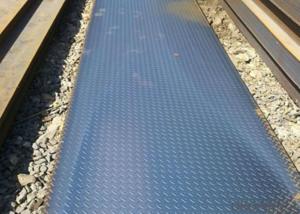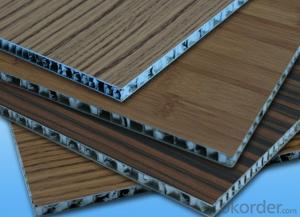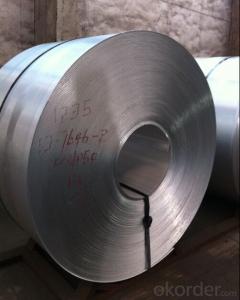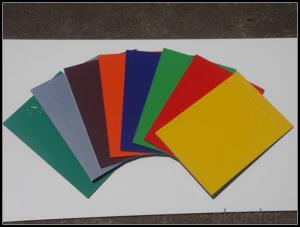Aluminum Sheets for Aluminium Composite Panel Facade Decoration - Good Price
- Loading Port:
- Shanghai
- Payment Terms:
- TT or LC
- Min Order Qty:
- 1000 m²
- Supply Capability:
- 20000 m²/month
OKorder Service Pledge
OKorder Financial Service
You Might Also Like
Structure of Aluminium Composite Panel Facade Decoration Description:
Coated aluminum coil/sheet are of a wide range of colors, which gives wonderful appearance no matter in residential and commercial constructions of great exhibition centers.
The coated aluminum coil/sheet have been widely used in the fields of construction and decoration( garage doors, ceiling etc.), electronic appliances, lighting decoration, air-condition air pipes, sandwich panels and drainages etc.
Main Features of Aluminium Composite Panel Facade Decoration
Extremely strong agglutination
Excellent weather resistance
Excellent fire-retardant performance
Light and easy to machining, excellent impact resistance, easy to maintain
Coating : PVDF, PE, Granite-textured, Wood-textured, Mirror
Color: at your option. ( We could mix the color according to your reqirement.)
Surface and rear aluminum foil can be coating with fresh color as your requirement.
All of Aluminum foil is made from famous aluminum manufacture
In the middle is the no-toxicity Plastic core
PVDF coating can be effected for 15 years, and the PE coating can be effected for 8 years.
Images of Aluminium Composite Panel Facade Decoration
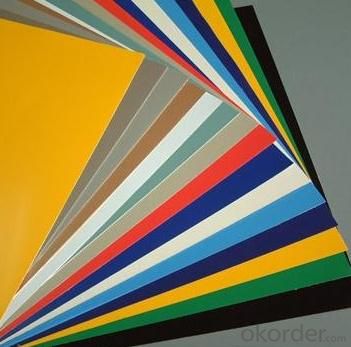

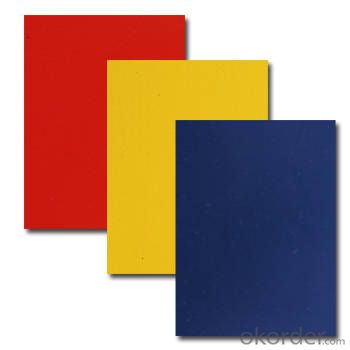
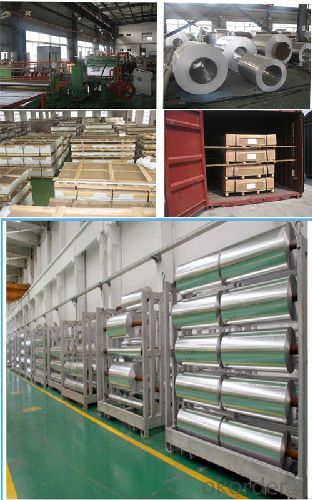
Aluminium Composite Panel Facade Decoration Specification:
| Specification | Recommend | |
| PVDF | 4*0.4mm | Most popular in the world for out door decoration |
| 4*0.5mm | Best for out door decoration in general | |
| 4*0.3mm | Economy also meet requirement for outdoor decoration | |
| 3*0.3mm | Popular for indoor decoration in commercial building | |
| 4*0.5mm Fireproof | Superior fireproof performance on the basis of the best specification | |
| PE | 3*0.3mm | Most popular in the world for indoor decoration |
| 3*0.21mm | Economy for indoor decoration in general | |
| Standard size | 1220*2440 and 1250*2440mm | |
| Accepted width | Max:1580mm | |
| Accepted length | Max:6000mm | |
| Accepted thickness | 2mm,3mm,4mm,5mm,6mm | |
| Aluminum alloy thickness | ACP thick | AL thick |
| 2mm | 0.06mm-0.15mm | |
| 3mm | 0.06mm-0.21mm | |
| 4mm | 0.06mm-0.55mm | |
| 5mm | 0.06mm-0.55mm | |
| Weight | 5kg/m2, based on 4*0.4mm,1400pcs/20'FCL | |
| Nonstandard | Sizes are available according your requirement | |
FAQ of Aluminium Composite Panel Facade Decoration
a.What is monthly capacity
---CNBM is one stated own company and our monthly capacity is about 20000㎡.
b. Now which countries do you export your goods?
----Now we export to South East Asia,Africa, North America,South America ect.
A Brief Guide On Aluminum Sheets
Aluminum is the material of choice across a wide range of industries today. This metal is abundantly available, can be molded in different forms and shapes, and is more light-weight than steel. Of the different forms in which aluminum is used, sheeting is one of the most popular. In fact, you are sure to come across at least one object made of aluminum sheets every day. Whether you are in a car, traveling, or trying to open a can, or you switch on the electric bulb for a light read-chances are, all these things will contain some aluminum sheeting in them.
Sheets are formed when the aluminum block is passed between rolls under pressure. As it is rolled and re-rolled, it thins out and becomes longer in the direction in which it is moving. It becomes a sheet when the rolling process is stopped at 0.249 to 0.006 inch.
Sheets are made of different alloys so that they have the required amount of flexibility and toughness. They are graded accordingly. People then choose the variety on the use to which they will be put. Two of the most popular grades are 1100 for pure aluminum and 2011 for minor machine parts. For tougher, more durable materials, a grade of 5052 is suitable.
Many industries prefer aluminum for its wonderfully versatile and lightweight quality. The transportation industry has always loved this metal that improves fuel economy, cuts down emissions, and boosts vehicle performance. No wonder, then, that since 2006, aluminum has overtaken iron to become the second most used material in new vehicles across the world. Increasingly, car-makers are opting to become more eco-friendly by using aluminum sheets for the panels of car bodies. Other than this, bodies of planes use sheets made of this metal owing to their light-weird, robust quality.
Aluminum products are popular in households as well. A variety of objects used to build houses, such as flashing, siding, and roofs have aluminum sheets in them. Metal workers and artists also like this versatile material that can be made into furniture and art installations.
Aluminum sheets come in various qualities. The best quality is highly resistant to corrosion. Sometimes manufacturers provide customizing options depending on your need. Metalsforasteel is a great dealer that provides aluminum sheets in a variety of measurements. It also offers to discount prices for larger orders of 1000 pounds or more.
- Q: 1 ton of aluminium=______ tons of Alumina
- After analyzing the solutions I felt i'd desire to describe a sprint extra what others have not mentioned. constantly examine what the producer prints out on the label the two interior the door jam or glove container as to the finished available weight the truck can carry. Payload (weight it could carry) and towing potential (weight it could tow) are 2 a number of issues. additionally, maximum one ton vehicles can carry extra beneficial than a ton. as an occasion: If the vehicles GVWR gross motor vehicle weight score is 12000 lbs. and the truck weighs 7000 lbs, then you rather can haul 5000 lbs. this is human beings, gas, shipment, each thing. keep in mind, this is the optimal. GCWR Gross blended weight score is that of the truck and towing motor vehicle. If as an occasion this is 15000 lbs, and your truck weighs 7000lbs. then you rather are turning out to be an empty truck and tow as much as 8000 lbs. on the lighter edge, a million/2 ton %. united statesgeneraly are purely that--one thousand to 1900 lbs. 3/4 ton are a sprint extra and would have a camper kit as nicely. One plenty are stable for flatbeds, and the terminology is purely that--a generalization. stable success, and look for the placard.
- Q: Are aluminum sheets suitable for electrical enclosures?
- Yes, aluminum sheets are suitable for electrical enclosures. Aluminum is a lightweight and durable material that offers excellent electrical conductivity and corrosion resistance, making it an ideal choice for protecting electrical components. Additionally, aluminum's thermal conductivity helps dissipate heat generated by the enclosed equipment, ensuring proper functioning and longevity.
- Q: A 15.1 g aluminum block is warmed to 53.2 °C and plunged into an insulated beakercontaining 32.6 g of water initially at 24.4 °C. The aluminum and the water are allowed to cometo thermal equilibrium.Assuming that no heat is lost, what is the final temperature of the water and aluminum?
- To solve this problem, you need the heat capacity of water and Al, I know off hand the heat capacity of water but you'll need to look it up for Al. From the problem, you know that the heat given up as the aluminum cools is gained by the water heating up. As there is no phase change, the heat gained (or lost) is mass * heat capacity * temperature change energy gained by water = energy lost by Al. Let Tf be the final temperature of the Al and water. 32.6 g * 4.18 J/gK * (Tf - 24.4C) = 15.1 g * heat capacity of Al * (53.2 C - Tf) Solve for Tf. Because there is almost twice as much water as Al and water has a higher heat capacity than Al, the temperature will be closer to 24.4C than it is to 53.2C
- Q: This question asks about the various types of paint that can be used specifically for aluminum sheets, indicating an interest in paint compatibility and options for this particular material.
- <p>There are several types of paints suitable for aluminum sheets, each offering unique properties. These include: 1. Acrylic Paints - Water-based, easy to apply, and offer good adhesion. 2. Epoxy Paints - Known for their durability and chemical resistance, they provide a strong bond to the metal. 3. Enamel Paints - Provide a hard, glossy finish and are resistant to chipping and scratching. 4. Polyester Paints - Offer excellent durability and UV resistance, making them suitable for exterior applications. 5. Powder Coatings - Applied electrostatically, they provide a tough, scratch-resistant finish. 6. Specialty Paints - Such as heat-resistant or anti-corrosive paints, designed for specific industrial applications. The choice of paint depends on the application, desired finish, and environmental conditions.</p>
- Q: This question asks for an explanation of the various types of paint that can be applied to aluminum sheets.
- <p>Aluminum sheets can be coated with different types of paints to enhance their appearance, durability, and functionality. The common types include: 1) Acrylic Paints: Known for their flexibility and resistance to weathering and UV rays. 2) Polyester Paints: These offer excellent adhesion and gloss. 3) Epoxy Paints: Known for their chemical resistance and durability. 4) Polyurethane Paints: They provide a tough, scratch-resistant finish. 5) Powder Coatings: These are electrostatically applied and offer a durable, weather-resistant finish. 6) Fluoropolymer Coatings: They provide excellent resistance to chemicals and UV degradation. Each type has specific properties that make it suitable for different applications and environments.</p>
- Q: What are the primary components that make up aluminum sheets?
- <p>Aluminum sheets are primarily composed of aluminum, which is a lightweight and malleable metal. They are made from pure aluminum or aluminum alloys, which may include small percentages of other elements to enhance specific properties such as strength, corrosion resistance, or workability. Common alloying elements include copper, magnesium, manganese, silicon, and zinc. The exact composition varies depending on the specific grade of aluminum and its intended use. Pure aluminum is soft and not commonly used for sheets; instead, alloys are preferred for their improved strength and durability.</p>
- Q: What are the common surface finishes for aluminum sheets?
- Aluminum sheets can be finished in various ways, including mill finish, brushed finish, anodized finish, and powder-coated finish. The mill finish refers to the untreated surface of the aluminum sheet, which has a slightly rough texture and may show imperfections. It is a basic and cost-effective option, often used in industrial applications or as a base for further finishing processes. For a textured appearance and to conceal minor scratches or imperfections, the brushed finish involves a mechanical brushing process that creates fine parallel lines on the aluminum sheet's surface. The anodized finish is achieved through an electrochemical process called anodization, which forms a protective oxide layer on the aluminum's surface. This finish enhances its corrosion resistance and durability, and it also offers a range of color options. Anodized aluminum sheets are commonly used in architecture or for decorative purposes. In the powder-coated finish, a dry powder is applied to the aluminum sheet's surface and then baked at high temperatures. This creates a durable and attractive finish that is resistant to chipping, scratching, and fading. Powder-coated aluminum sheets are often used outdoors in applications such as building facades, signage, or automotive parts. Ultimately, the choice of surface finish for aluminum sheets depends on the desired appearance, functionality, and specific requirements of the application.
- Q: How does the thickness of aluminum sheet affect its strength?
- The thickness of an aluminum sheet directly affects its strength. Generally, thicker sheets tend to be stronger and more rigid due to the increased amount of material present. Thicker sheets are capable of withstanding higher loads and are less prone to bending or deformation under stress. However, it is important to note that other factors such as alloy composition and processing techniques also play a significant role in determining the overall strength of an aluminum sheet.
- Q: Is it possible to use adhesive instead of fasteners to bond aluminum sheets to a structure?
- <p>Yes, you can use an adhesive to attach aluminum sheets to a structure. However, it's important to choose an adhesive that is specifically designed for bonding aluminum, as not all adhesives provide the necessary strength and durability. Structural adhesives that are compatible with aluminum can offer a strong bond and are often used in applications where a clean, seamless appearance is desired or where fasteners are not suitable. It's crucial to ensure that the adhesive is resistant to the environmental conditions the structure will be exposed to, such as moisture, temperature fluctuations, and UV radiation. Always follow the manufacturer's instructions for surface preparation and application to achieve the best results.</p>
- Q: This question asks for the various types of adhesives that can be used for bonding aluminum profiles when constructing exterior cladding.
- <p>For bonding aluminum profiles in exterior cladding, several types of adhesives are commonly used. These include: 1. Structural adhesives, which provide strong and durable bonds suitable for load-bearing applications. 2. Silicone sealants, known for their flexibility and resistance to weathering, making them ideal for sealing gaps and joints. 3. Acrylic adhesives, which offer good adhesion and flexibility, and are often used for bonding aluminum to other materials. 4. Epoxy adhesives, known for their high strength and resistance to chemicals, making them suitable for demanding environments. 5. Polyurethane adhesives, which provide strong bonds and excellent resistance to moisture and temperature changes. The choice of adhesive depends on factors such as the specific application, environmental conditions, and required performance characteristics.</p>
Send your message to us
Aluminum Sheets for Aluminium Composite Panel Facade Decoration - Good Price
- Loading Port:
- Shanghai
- Payment Terms:
- TT or LC
- Min Order Qty:
- 1000 m²
- Supply Capability:
- 20000 m²/month
OKorder Service Pledge
OKorder Financial Service
Similar products
Hot products
Hot Searches
Related keywords


